|
|
| Sei in: Cinema e Medioevo ® Indice alfabetico dei film |
ROMEO AND JULIET
1966, regia di Paul Czinner
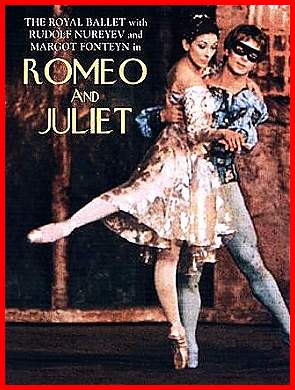
Scheda: Nazione: GB - Produzione: Poetic Films - Distribuzione: Rank, Embassy Pictures Corporation - Soggetto: da Giulietta e Romeo di William Shakespeare - Fotografia: S.D. Onions - Montaggio: Philip Barnikel - Scenografia: Nicholas Georgiadis - Musiche: Sergei Prokofiev - Formato: Panoramica Eastmancolor - Durata: 124'.
Cast: Margot Fonteyn, Rudolf Nureyev, David Blair, Desmond Doyle, Julia Farron, Michael Somes, Anthony Dowell, Derek Rencher, Leslie Edwards, Georgina Parkinson, Gerd Larsen, Ronald Hynd, Christopher Newton, Betty Kavanagh.
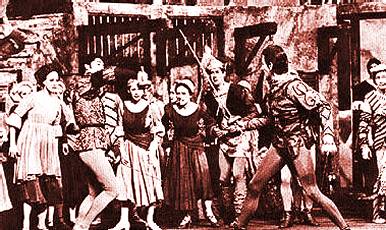
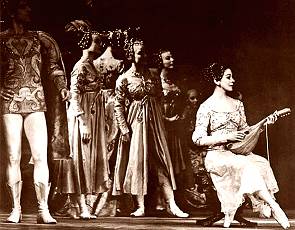
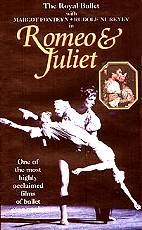
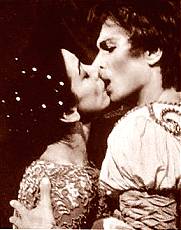
![]() Trama e commenti: cinematografo.it
- kataweb.it
-
mymovies.it
- film.spettacolo.alice.it:
«Nella piazza del mercato di Verona, Tebaldo dei Capuleti e Romeo dei Montecchi si affrontano in duello ma l'arrivo del principe riesce a farli desistere. Giulietta, figlia di messer Capuleti, è stata promessa in sposa a Paride ma nel corso di una festa conosce Romeo e se ne innamora. Nel frattempo Romeo che si è sposato in segreto con Giulietta aiutato da frate Lorenzo, medita di vendicare l'uccisione dell'amico
Mercuzio. Grandi e memorabili interpreti del Royal Ballet di Londra nell'allestimento di MacMillan del celeberrimo balletto di Prokofiev-Lavrovskij andato in scena l'anno prima nella capitale inglese. La regia non
aggiunge nulla al balletto, e risulta anche un po' noiosa per in non
appassionati».
Trama e commenti: cinematografo.it
- kataweb.it
-
mymovies.it
- film.spettacolo.alice.it:
«Nella piazza del mercato di Verona, Tebaldo dei Capuleti e Romeo dei Montecchi si affrontano in duello ma l'arrivo del principe riesce a farli desistere. Giulietta, figlia di messer Capuleti, è stata promessa in sposa a Paride ma nel corso di una festa conosce Romeo e se ne innamora. Nel frattempo Romeo che si è sposato in segreto con Giulietta aiutato da frate Lorenzo, medita di vendicare l'uccisione dell'amico
Mercuzio. Grandi e memorabili interpreti del Royal Ballet di Londra nell'allestimento di MacMillan del celeberrimo balletto di Prokofiev-Lavrovskij andato in scena l'anno prima nella capitale inglese. La regia non
aggiunge nulla al balletto, e risulta anche un po' noiosa per in non
appassionati».
![]() Plot Summary, Synopsis, Review: entertainment.msn.com
- tvguide.com:
«Producer-director Czinner made
Der Rosenkavalier a few years before as a film and it played to moderate houses. He tried the same thing here as he set up eight cameras at Pinewood Studios and photographed the Prokofiev ballet that played at London's Royal Opera House in 1965.
With spotty choreography by Kenneth MacMillan and a Juliet who was old enough to be the real Juliet's mother (Fonteyn was 46 when she made this), plus a Romeo who wore more makeup than his lover, it was little more than a lensed ballet. The picture is in three acts, with a brief intermission after the first. To help the audience know what's happening, there is a prolog before each act to set the scene and explain what's about to transpire. The more intimate moments are danced well, but the ensemble pieces leave much to be desired and the post-production dubbing of sound effects is shoddy. The glorious score is wonderfully conducted by Lanchbery, and...».
Plot Summary, Synopsis, Review: entertainment.msn.com
- tvguide.com:
«Producer-director Czinner made
Der Rosenkavalier a few years before as a film and it played to moderate houses. He tried the same thing here as he set up eight cameras at Pinewood Studios and photographed the Prokofiev ballet that played at London's Royal Opera House in 1965.
With spotty choreography by Kenneth MacMillan and a Juliet who was old enough to be the real Juliet's mother (Fonteyn was 46 when she made this), plus a Romeo who wore more makeup than his lover, it was little more than a lensed ballet. The picture is in three acts, with a brief intermission after the first. To help the audience know what's happening, there is a prolog before each act to set the scene and explain what's about to transpire. The more intimate moments are danced well, but the ensemble pieces leave much to be desired and the post-production dubbing of sound effects is shoddy. The glorious score is wonderfully conducted by Lanchbery, and...».